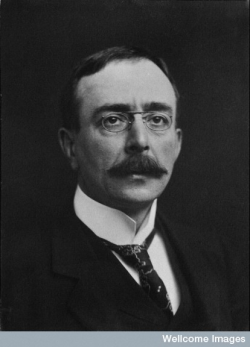Sir Charles Scott Sherrington

Wellcome Images
- Born
- 27 November 1857
- Died
- 4 April 1952 (age 94)
Charles Scott Sherrington was a Nobel Prize winning British physiologist who contributed massively to our understanding of the nervous system, to such an extent the field of neurology might be unrecognisable without him.
Sherrington was the son of Caleb Rose, a classical scholar and archaeologist. He picked up a love for art from his father that he carried with him throughout his life; visiting art galleries in Italy in between examining cholera patients. Initially, his education got off to a rocky start after a bank failure left his family unable to afford the fees at Cambridge. Nevertheless, after passing the entrance exams for the Royal College of Surgeons he finally gained admission to Cambridge as a non-collegiate student in October 1879.
Early on in his career, between 1885 and 1886, he spent time working on bacteriology during the Fifth Cholera Pandemic, which was the last to seriously affect Europe. He met with Rudolph Virchow, one of the fathers of public health, before being sent to spend six weeks learning techniques with Robert Koch, considered the founder of modern bacteriology.
Sherrington later became a Fellow at Oxford, with his teaching severely disrupted by the outbreak of the First World War. During the war, he worked 13 hours a day, from 07:30 to 20:30, researching industrial fatigue.
Sherrington was responsible for many great leaps in neurology and physiology, including coining the term ‘neuron’ itself. One of Sherrington’s most famous innovations is Sherrington’s Second Law, which states that as one muscle tenses its opposing muscle relaxes, allowing smooth movement. He also researched human senses, further undermining the traditional belief that we possess only five. He divided the senses into three categories; exteroceptors, interoceptors and proprioceptors, which covered information received from outside the body, inside the body and about the positioning of the body respectively. He received a Nobel Prize, along with Edgar Adrian, for his contributions to neurology in 1932.
In his life he was also noted for his almost encyclopaedic knowledge of experimental medicine as well as a writing style so elaborate, even his fellow Nobel Prize winner had difficulty making sense of it.
This page was written by a Biology: Changing the World volunteer.



